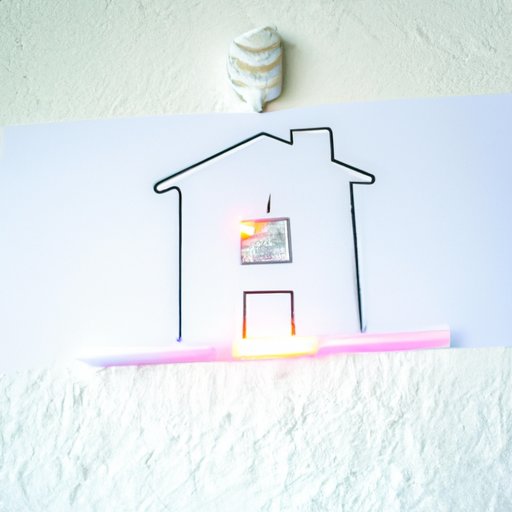Introduction
Electricity is an essential part of daily life in most homes. From powering the lights and keeping the refrigerator running to enabling you to watch TV or browse the internet, electricity is used for a variety of purposes. But what uses the most electricity at home? This article explores common habits, utility bills, energy-efficient alternatives, electronic devices, and renewable energy sources to help you make smarter choices when it comes to conserving energy.

Analyzing Typical Household Habits to Determine What Uses the Most Electricity
One of the best ways to determine what uses the most electricity in your home is to analyze your typical household habits. Pay attention to how often you leave lights on, run the dishwasher, do laundry, or keep the thermostat set at a certain temperature. These are all examples of common electricity-using habits that can add up quickly over time if not monitored carefully.
Once you’ve identified your electricity-using habits, you can start to develop strategies for reducing your overall electricity consumption. Simple changes like replacing light bulbs with LED bulbs, turning off lights when not in use, and only running the dishwasher when full can all make a big difference in the long run.

Examining Utility Bills to Identify Major Electricity Consumers
Your utility bill is a great resource for understanding how much electricity you’re using and where it’s going. Understanding your utility bill can help you pinpoint which areas of your home are major electricity consumers and need to be addressed. Depending on your provider, your bill may include information about total electricity usage, peak hours of usage, and individual appliance breakdowns.
Tips for reading and analyzing your utility bill include looking for patterns in your electricity usage and comparing month-to-month usage to look for discrepancies. If you notice any inconsistencies or unusually high usage, it could indicate that something is wrong and needs to be addressed. For example, if your air conditioning unit is running more than normal, it could be due to an issue with the unit itself or a leaky window.
Exploring Energy-Efficient Alternatives for Home Appliances
Replacing your old, inefficient home appliances with newer, energy-efficient models can have a significant impact on your electricity consumption. Newer models tend to use less electricity, resulting in lower utility bills and a reduced environmental impact. Additionally, many energy-efficient appliances come with government-sponsored tax credits and other incentives that can help offset the cost of purchasing and installing them.
When shopping for new appliances, look for the ENERGY STAR label, which indicates that the appliance meets certain energy efficiency standards. Additionally, compare the energy ratings of different models to determine which one will be the most cost-effective in the long run. Finally, consider hiring a professional to install your new appliances to ensure that they are working correctly and efficiently.
Investigating How Much Energy is Used by Specific Electronic Devices
Electronic devices such as computers, TVs, and gaming consoles can also be major electricity consumers. To calculate how much energy your devices are using, you can use a wattage meter or an online calculator to estimate their energy usage. The wattage meter is a simple device that measures the amount of power your device is consuming. Alternatively, you can use an online calculator to estimate the energy usage based on the type of device and how often it’s used.
When it comes to choosing electronic devices, look for models that are energy efficient and use minimal power when in standby mode. Additionally, consider investing in a power strip with a switch so you can easily turn off all your electronics when not in use.

Comparing Average Electricity Use in Homes of Different Sizes
The size of your home can also have an impact on your electricity usage. Smaller homes generally require less electricity to power lights, appliances, and other electronics. However, larger homes typically have more rooms and thus require more electricity to power them. Additionally, factors such as insulation, climate, and the age of the home can all affect electricity usage.
To get a better idea of how much electricity an average home uses, compare the square footage of your home to the average electricity usage of other homes of similar size. This will give you a better understanding of how much electricity your home is using and whether or not it’s above or below average.
Evaluating the Benefits of Using Renewable Energy Sources at Home
Using renewable energy sources at home can also help reduce your electricity consumption. Renewable energy sources include solar, wind, and geothermal energy, as well as biomass, hydropower, and nuclear energy. While some of these sources require special equipment and installation, others can be implemented relatively easily and without significant upfront costs.
Using renewable energy sources can provide numerous benefits, including reduced electricity bills, environmental sustainability, and increased energy independence. Additionally, many governments offer financial incentives for using renewable energy sources, making the transition even more attractive.
Conclusion
Understanding what uses the most electricity in your home is key to reducing your overall electricity consumption. By analyzing your household habits, examining your utility bills, exploring energy-efficient alternatives, evaluating electronic devices, and considering renewable energy sources, you can make informed decisions about how to best conserve energy. Additionally, understanding average electricity use in homes of different sizes can help you determine if your home is using more or less electricity than the average.
Overall, reducing your home’s electricity consumption can lead to lower utility bills, a smaller environmental footprint, and increased energy independence. By implementing the tips outlined in this article, you can take steps towards becoming a more energy-conscious consumer.


